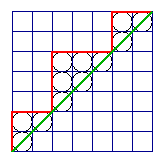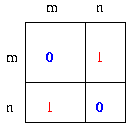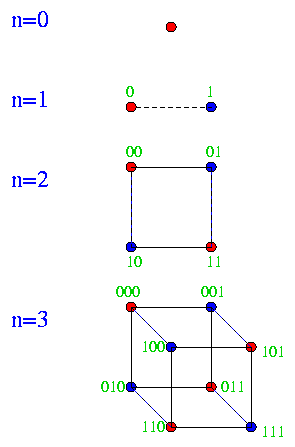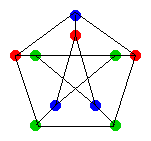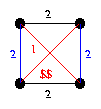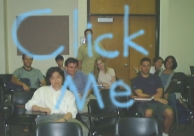
|
Date |
Topic |
Reading |
Exercises |
Homework |
|
W, 7/5 |
3 ways to color balls |
Frieze's notes Rosen §§4.1, 4.6; Roman §§4.4-4.6 |
|
|
|
Th, 7/6 |
Relearning to count: permutations, combinations, and binomial coefficients |
Frieze: Counting 251 notes: Count without counting Rosen §§4.3, 4.6; Roman §§4.4-4.6 |
Ex1 |
|
|
F, 7/7 |
Binomal coeffs, indentities, and _the_ theorem |
Frieze: Binomial coeffs 251: Flexing your counting... 251: Polynomials that count Rosen §4.6; Roman §§4.7 & 5.2 |
Ex2 |
Hw1 due T, 7/11 |
|
M, 7/10 |
Multinomial coefficients Pigeonhole principle |
Frieze: Multinomial coeffs Frieze: Pigenhole principle Rosen §4.2; Roman §§4.3, 4.8, 5.1 |
Ex3 |
|
|
T, 7/11 |
Grid-path problems and Catalan #s |
Frieze: Grid-path problems Exercises on Catalan and related #s |
Ex4 |
Hw1 due |
|
W, 7/12 |
Fibonacci and friends |
251: A number you can... Rosen §5.1; Roman §4.9 |
Ex5 |
Hw2 due M, 7/17 |
|
Th, 7/13 |
Solving linear recurrences |
Frieze: Linear recurrences Rosen §§5.2 & 5.3; Roman §4.10 & 4.11 |
Ex6 |
|
|
F, 7/14 |
Solving (nonhomogeneous) recurrences |
Frieze: Linear recurrences(same as above) Roman §4.12 |
|
|
|
Su, 7/16 |
Problem session 7:00pm, room tba |
|
|
|
|
M, 7/17 |
Recurrences for partition problems, permutations, derangements, and triangulations |
Frieze: Permutations Frieze: Partition recurrences Frieze: Triangulations and gfs |
Ex7 |
Hw2 due Hw3 due F, 7/21 |
|
T, 7/18 |
To exclude or not to exclude... |
Frieze: Inclusion-exclusion 251: To exclude or not to exclude Rosen §§5.4 & 5.5; Roman §§5.5-5.7 |
|
|
|
W, 7/19 |
Exam 1 (solutions) |
Exam 1 sample problems Solutions for above |
|
|
|
Th, 7/20 |
Intro to discrete probability: Monty Hall problem and Birthday paradox |
Frieze: Intro to descrete prob. 251: Probability Rosen §4.4 |
|
|
|
F, 7/21 |
Conditional probability and pitfalls |
Frieze: Conditional probability Frieze: Boole's inequality & 2-coloring a set system 251: Probability pitfalls Rosen §4.5 |
|
Hw3 due Hw4 due T, 7/25 |
|
M, 7/24 |
Random variables and expectation Graph Theory |
Frieze: Random variables 251: Great Expectations Rosen §§4.5 & 7.1 |
|
|
|
T, 7/25 |
Graph Thoery: Definitions, representations, and isomoprhisms |
Frieze: Intro Graph Theory 251: Graph Theory Rosen §§7.2 & 7.3 |
Ex8 |
Hw4 due Hw5 due F, 7/28 |
|
W, 7/26 |
Paths and walks |
Frieze: Paths and walks 251: Blowing in the wind Rosen §7.4 |
Ex9 |
|
|
Th, 7/27 |
Graph forestry: trees |
Frieze: Trees Rosen §7.4, §§8 |
|
|
|
F, 7/28 |
Guest Lecture: Coloring Euler's Plane by Goeff Atkinson |
251: Planar graphs Rosen §7.7 |
|
Hw5 due Hw6 due T, 8/1 |
|
M, 7/31 |
Euler, Euler, he's our man... |
Frieze: Eulerian graphs Rosen §7.5 |
|
|
|
T, 8/1 |
De Bruijn Graphs, the Chinese Postman Problem, and matchings |
Frieze: Matchings 251: Math of 1950's dating |
Ex10 |
Hw6 due
(solutions) Hw7 due F, 8/4 |
|
W, 8/2 |
Problem Day |
|
|
|
|
Th, 8/3 |
Exam 2 (solutions) |
Exam 2 sample problems Solutions for above |
|
|
|
F, 8/4 |
Review: Exam 2 solutions, matchings, and vertex covers |
|
|
Hw7 due (solutions) Extra Credit due Th, 8/10 |
|
M, 8/7 |
Review: Hw7 solutions, derangements, and even permutations |
|
|
|
|
T, 8/8 |
Cryptography: The RSA cryptosystem |
An intro to cryptography RSA Labs crypotgraphy FAQ RSA lecture slides |
|
Final Exam due Th 8/10 by 1:00pm |
|
W, 8/9 |
Error-Correcting codes |
|
|
|

